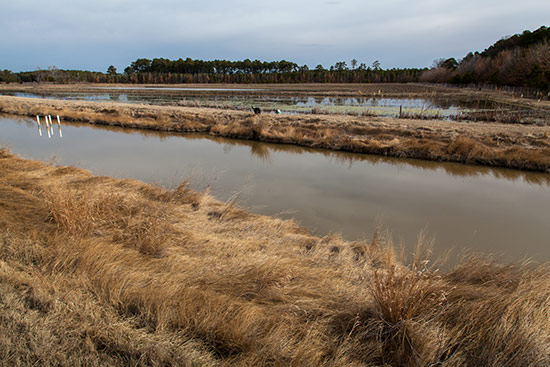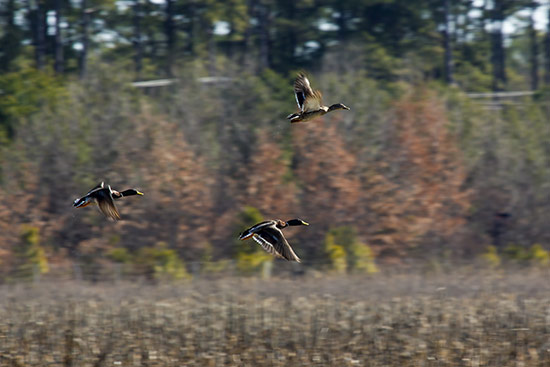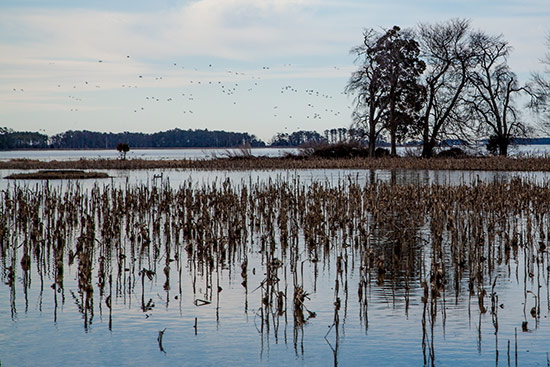Conserving waterfowl habitat at Mallard Haven River Farm
Landowner has created a safe haven for waterfowl on Maryland’s Eastern Shore.

On a blue bird day in Church Creek, Maryland, a white pickup truck bounces down a dirt driveway, splashing through fresh mud puddles and leaving ripples in its wake. The low whirring of female Northern pintail ducks in the middle of their courtship is exuberant, and there is excitement in the air – it is almost time for the birds to make their long migration north.
The truck rounds a bend and hundreds of waterfowl take flight, seeking solace in the nearby Honga River. Landowner Jerry Harris steps out of the truck, his two hunting dogs, Bo and Maddie, in tow. Jerry has owned Mallard Haven River Farm for nearly 20 years and has transformed it from an open pasture to an ideal stopover site for thousands of waterfowl migrating along the Atlantic Flyway.
Harris recounts purchasing the farm as an open pasture with a ditch down the center in the late ‘90s. Initially, he battled saltwater intrusion and high-tide floods of the Chesapeake Bay. His solution involved closing off the connection between the ditch and the Bay and creating a freshwater storage area that can now hold up to 6.5 million gallons of water. With financial assistance from the state of Maryland, Ducks Unlimited and North American Wetlands Conservation Act Grants (NAWCA), he built berms to create a series of separate water impoundments for use by waterfowl across 80 acres of the 230-acre farm.
Harris has hired two full-time employees to help maintain the property. “We’ve tried to do everything to improve the efficiency of our work,” Harris said. “We have pipes in all the impoundments that lead to a main water storage ditch, so we can connect our portable pumps right to the pipes and drive the water wherever we would like. If we’re irrigating this field during a dry period we don’t have to hook hoses up or anything.”
Because his land is privately owned, Harris has the freedom to experiment with unconventional conservation practices. His latest endeavor? Moist soils management, or the slow draw down of water from the impoundments to foster the growth of wetland plants like smartweed, fall panicum and fox tail. “As the water gradually comes down, it will support different kinds of weeds, and if you are good enough at it you can have a whole platter of foods that fulfill the ducks’ dietary needs,” Harris said. Moist soils management is good for the wildlife and the farmer: it cuts fertilizer use, and mechanical tilling is only needed about once every five years.

In the past, Harris grew corn on his farm to provide high-energy food for visiting waterfowl. Harris admits that deer and their affinity for corn have presented a challenge to his habitat management practices. For this reason, he plans to grow rice instead. “It’s literally the same kind of high-carbohydrate food that corn is,” Harris said. “The big advantage is that the deer don’t eat rice. In some fields, nearly half of the corn crop gets eaten by the deer.”
Harris has been an avid hunter since he was a young boy; growing up hunting with his grandfather on the bays north of San Francisco cultivated his passion for conserving wildlife habitat. He now owns three farms in Maryland and one in Montana, all under conservation easements through Ducks Unlimited, the largest land conservation owner in the United States, of which he sits on the board.
“The farm is big enough that on a windy day you can be shooting on the farm and the upwind birds will still be there. With the wild ducks, the thing you want to do if you want to keep them is not disturb them too much, otherwise they find another place to go,” Harris said. He has even calculated exactly how many ducks he and his guests can harvest in a year without negatively impacting waterfowl populations, setting the limit at 175 ducks from all four farms.

Harris designates 20 percent of his time to sitting on the board of Ducks Unlimited and of Waterfowl Chesapeake, a Maryland-based non-profit whose mission is to create, restore and conserve waterfowl habitat in the Chesapeake Bay Region. Together they help draw awareness to protecting area wetlands.
Judy Price, the executive director of Waterfowl Chesapeake, has helped the organization raise more than $5 million for habitat restoration and conservation education projects. Waterfowl Chesapeake, the umbrella organization of the annual Waterfowl Festival, held in November in Easton, Maryland, recently created an alliance for waterfowl conservation that consists of a panel of scientific experts that offer advice to current and prospective habitat restoration initiatives. They have also created a restoration project registry, expanding the visibility of high-value projects to the public and potential funders.

When asked why protecting waterfowl habitat is a priority, Price responded, “The annual migration of waterfowl truly enhances our lives throughout the Chesapeake region and, in particular, the Eastern Shore. Not only do we gain ecological benefits, but also significant economic value, from a healthy waterfowl community. By focusing on maintaining strong habitat, hopefully, we can avoid people, years from now, saying, ‘I remember seeing ducks and geese in the skies. Whatever happened to them?’”
To view more photos, visit the Chesapeake Bay Program Flickr page.

Comments
So it's nice to see that Mr Harris takes the time and has the energy to harness the progress of all waterfowl in our region here around the Chespeake. For those of us that love the sport it's great to see the efforts of many not just Jerry. I can verify some of his efforts mentioned in this article as I have a farm I lease next to his in dorchester county and have witnessed the intense amount of birds that hang on his farm and although I have not personally walked the farm ,wish I had just from a visual standpoint there must be great habitats there as so many birds settle there. I briefly met him years ago and hope he continues enriching the land. Way to go harris
Moist soil isn't unconventional - USFWS first published a guide for landowners called "Weeds for Duck Marshes" in 1933.
Great story. I knew a farmer on the lower Delmarva in Virginia that did something similar 25 years ago when I was involved in some bird research down there. The Delmarva is a great part of the eastern fly way. Always great to hear of work like this! Good job, nicely done on the article.
Kudos to Jerry and Bobbi Harris on a job well done! Great article.
Great job! Loved reading this! Very interesting and informative!
Thank you!
Your comment has been received. Before it can be published, the comment will be reviewed by our team to ensure it adheres with our rules of engagement.
Back to recent stories